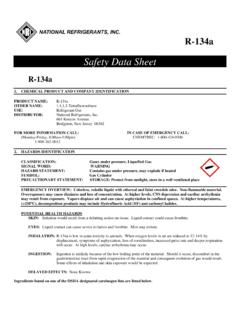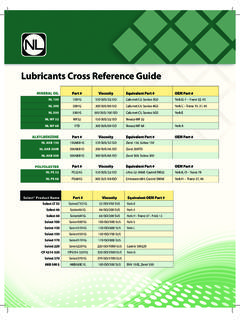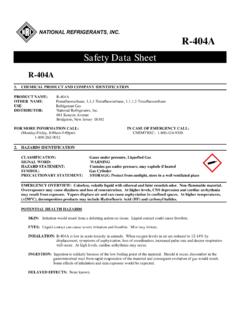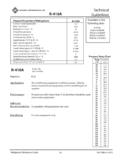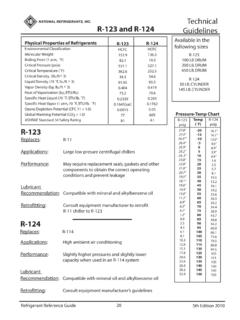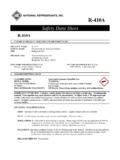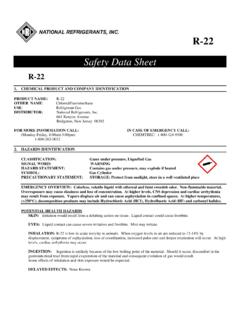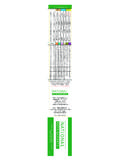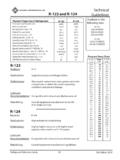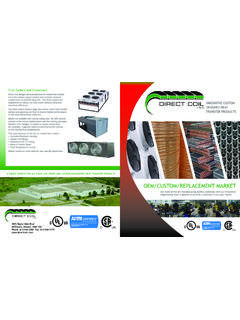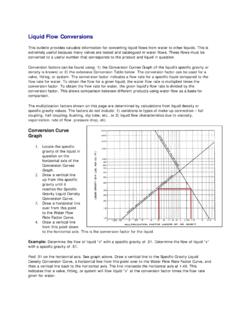Transcription of SAFETY DATA SHEET - Refrigerants
1 SAFETY data SHEET Page 1 of 8 Current Issue Date: May 2018 150 OIL PRODUCT: propylene glycol (Inhibited Solution) PRODUCT CODES: 55PG30, 5PG96, 5PG40, 55PG40, 55PG45, 275PG35D, 55PG35D, 55PG35, 1PG70, 5PG70, 55PG70 CHEMICAL NAME/FAMILY: Glycols OTHER NAME: Coolant MANUFACTURER: NATIONAL Refrigerants , INC. ADDRESS: 11401 Roosevelt Boulevard Phila., Pa. 19154 INFORMATION: 800-262-0012 EMERGENCY: 800-424-9300 DATE: 5/2018 PREPARER: Matt Callahan CLASSIFICATION: Not classified as hazardous according to 29 CFR (2012) OTHER HAZARDS: SKIN AND EYE CONTACT: Prolonged contact may cause minor skin irritation. propylene glycol (CAS#57-55-6) 35-96 % Demineralized Water (CAS#7732-18-5) < 65 % Dipotassium Hydrogen Phosphate (CAS#7758-11-4) < 5 % COMMON NAME and SYNONYM: Coolant There are no stabilizers or impurities that contribute to the classification of the material identified in section 2 1.
2 CHEMICAL PRODUCAT AND COMPANY INFORMATION 2. HAZARD IDENTIFICATION 3. COMPOSITION/ INFORMATION ON INGREDIENTS 4. FIRST AID MEASURES INHALATION: EYE CONTACT: SKIN CONTACT: INGESTION: Move person to fresh air; if effects occur, consult a physician. Flush eyes thoroughly with water for several minutes. Remove contact lenses after the initial 1-2 minutes and continue flushing for several additional minutes. If effects occur, consult a physician, preferably an ophthalmologist. Wash skin with plenty of water. No emergency medical treatment necessary. SAFETY data SHEET Page 2 of 8 Current Issue Date: May 2018 150 OIL EXTINGUISHING MEDIA: Water fog of fine spray. Dry chemical & carbon dioxide fire extinguishers. Foam. Do not use direct water stream, may spread fire. Alcohol resistant foams (ATC type) are preferred.
3 General purpose synthetic foams (including AFFF) or protein foams may function, but will be less effective. UNUSUAL FIRE AND EXPLOSION HAZARDS: Container may rupture from gas generation in a fire situation. Violent steam generation or eruption may occur upon application of direct water stream to hot liquids. Liquid mist of the product can burn. Flammable concentrations of vapor can accumulate at temperatures above flash point. FIRE FIGHTING PROCEDURES: Keep people away. Isolate fire and deny unnecessary entry. Use water spray to cool fire exposed containers and fire affected zone until fire is out and danger of re-ignition has passed. Fight fire from protected location or safe distance. Consider the use of unmanned hose holders or monitor nozzles. Immediately withdraw all personnel from the area in case of rising sound from venting SAFETY device or discoloration of the container.
4 Burning liquids may be extinguished by dilution with water. Do not use direct water stream, may spread fire. Move container from fire area if this is possible without hazard. Burning liquids may be moved by flushing with water to protect personnel and minimize property damage. SPECIAL PROTECTIVE EQUIPMENT FOR FIREFIGHTERS: Wear positive-pressure self-contained breathing apparatus (SCBA) and protective fire fighting clothing (includes fire fighting helmet, coat, pants, boots, and gloves). If protective equipment is not available or not used, fight fire from a protected location or safe distance. HAZARDOUS COMBUSTION PRODUCTS: During a fire, smoke may contain the original material in addition to combustion products of varying composition which may be toxic and/or irritating. Combustion products may include and are not limited to: Carbon monoxide, Carbon dioxide.
5 ADVICE TO PHYSICIANS: No specific antidote. Treatment of exposure should be directed at the control of symptoms and the clinical 5. FIRE FIGHTING MEASURES SAFETY data SHEET Page 3 of 8 Current Issue Date: May 2018 150 OIL IN CASE OF SPILL OR OTHER RELEASE: Small spills: Absorb with materials such as cat litter, sawdust, vermiculite. Collect in suitable and properly labeled container. Large spills: Dike area to contain spill. Recover spilled material if possible. See Disposal Considerations section for additional information. PERSONAL PRECAUTIONS: Use appropriate SAFETY equipment. For additional information, refer to Exposure Controls and Personal Protection section. ENVIRONMENTAL PRECAUTIONS: Prevent from entering into soil, ditches, sewers, waterways and/or groundwater. See Ecological Information section. HANDLING: (Always wear recommended personal protective equipment) Ventilation: Provide general and/or local exhaust ventilation to control airborne levels below the exposure guidelines.
6 Other Precautions: Spills of these organic materials on hot fibrous insulations may lead to lowering of the auto- ignition temperatures possibly resulting in spontaneous combustion. STORAGE: Store below: 121 deg. C (250 deg. F). Do not store in: galvanized steel. EXPOSURE GUIDELINES INGREDIENT NAME ACGIH TLV OSHA PEL OTHER LIMIT propylene glycol NA NA 10 mg/m3 TWA 8 AIHA WEEL PERSONAL PROTECTION Respiratory Protection: Atmospheric levels should be maintained below the exposure guideline. When respiratory protection is required for certain operations, use an approved air- purifying respirator. In dusty or misty atmospheres, use and approved particulate respirator. Ventilation: Provide general and/or local exhaust ventilation to control airborne levels below the exposure guidelines. Eye Protection: Use SAFETY glasses. 6.
7 ACCIDENTAL RELEASE MEASURES 7. HANDLING AND STORAGE 8. EXPOSURE CONTROLS/PERSONAL PROTECTION SAFETY data SHEET Page 4 of 8 Current Issue Date: May 2018 150 OIL Other Protective Equipment: No precautions other than clean body-covering clothing should be needed. Use gloves chemically resistant to this material. APPEARANCE: Light Blue Liquid ODOR: Mild ODOR THRESHOLD: Not Determined PH: 9-11 FREEZING POINT: <= -51 deg. C / <= -60 deg. F BOILING POINT: (760 mmHg) 162 deg. C / 323 deg. F FLASH POINT: 102 deg. C / 216 deg. F Closed Cup EVAPORATION RATE: (Butyl Acetate = 1) FLAMMABILITY LEL/UEL: LEL= (V)100 UEL= (V)130 VAPOR PRESSURE: mmHg 20 deg. C VAPOR DENSITY: (Air=1) RELATIVE DENSITY: (Water=1) 20 deg. C SOLUBILITY: 100% by weight 20 deg. C PARTITION COEFFICIENT Not Determined n-Octanol/water: Not Determined AUTO IGNITION TEMPERATURE: 416 deg.
8 C / 780 deg. F DECOMPOSITION TEMPERATURE: Not Determined VISCOSITY: Low PERCENT VOLATILES: 98 NOTE: Physical and Chemical Properties are based on a 96% solution of propylene glycol . Diluted concentrations of propylene glycol may have slightly different Properties. STABILITY/INSTABILITY: Thermally stable at recommended temperatures and pressures. CONDITIONS TO AVOID: Product can oxidize at elevated temperatures. Generation of gas during decomposition can cause pressure in closed systems. MATERIALS TO AVOID: Avoid contact with: Strong acids, strong bases and strong oxidizers. THERMAL DECOMPOSITION: Decomposition products depend upon temperature, air supply and the presence of other materials. Decomposition products can include and are not limited to: Aldehydes, Alcohols, and Ethers. HAZARDOUS POLYMERIZATION: Will not occur. 9. PHYSICAL AND CHEMICAL PROPERTIES 10.
9 STABILITY AND REACTIVITY SAFETY data SHEET Page 5 of 8 Current Issue Date: May 2018 150 OIL ACUTE TOXICITY: PERORAL Rat; female; LD50 = 20300 mg/kg PERCUTANEOUS Based on information for a similar material: Rabbit; LD50=> 10000 mg/kg DEVELOPMENTAL TOXICITY: Contains component(s) which did not cause birth defects or any other fetal effects in lab animals. The component(s) is/are: propylene glycol . REPRODUCTIVE TOXICITY: Contains component(s) which did not interfere with reproduction in animal studies. Contains component(s) which did not interfere with fertility in animal studies. The component(s) is/are: propylene glycol . CHRONIC TOXICITY AND CARCINOGENICITY: Similar formulations did not cause cancer in laboratory animals. GENETIC TOXICOLOGY: In Vitro: In vitro genetic toxicity studies were negative. In Vitro: Genetic toxicity studies in animals were negative for component(s) tested.
10 SIGNIFICANT data WITH POSSIBLE RELEVANCE TO HUMANS: In rare cases, repeated excessive exposure to propylene glycol may cause central nervous system effects. POTENTIAL HEALTH EFFECTS: EFFECTS OF SINGLE ACUTE OVEREXPOSURE INHALATION: At room temperature, exposure to vapor is minimal due to low volatility. Mist may cause irritation of upper respiratory tract (nose and throat). EYE CONTACT: May cause slight temporary eye irritation. Corneal injury is unlikely. SKIN CONTACT: Prolonged contact is essentially nonirritating to the skin. Repeated contact may cause flaking and softening of skin. SKIN ABSORPTION: Prolonged skin contact is unlikely to result in absorption of harmful amounts. INGESTION: Very low toxicity if swallowed. Harmful effects not anticipated from swallowing small amounts. 11. TOXICOLOGIAL INFORMATION SAFETY data SHEET Page 6 of 8 Current Issue Date: May 2018 150 OIL CHRONIC, PROLONGED OR REPEATED OVEREXPOSURE EFFECTS OF REPEATED OVEREXPOSURE: In rare cases, repeated excessive exposure to propylene glycol may cause central nervous system effects.
